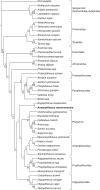New Eocene primate from Myanmar shares dental characters with African Eocene crown anthropoids
- PMID: 31388005
- PMCID: PMC6684601
- DOI: 10.1038/s41467-019-11295-6
New Eocene primate from Myanmar shares dental characters with African Eocene crown anthropoids
Abstract
Recent discoveries of older and phylogenetically more primitive basal anthropoids in China and Myanmar, the eosimiiforms, support the hypothesis that Asia was the place of origins of anthropoids, rather than Africa. Similar taxa of eosimiiforms have been discovered in the late middle Eocene of Myanmar and North Africa, reflecting a colonization event that occurred during the middle Eocene. However, these eosimiiforms were probably not the closest ancestors of the African crown anthropoids. Here we describe a new primate from the middle Eocene of Myanmar that documents a new clade of Asian anthropoids. It possesses several dental characters found only among the African crown anthropoids and their nearest relatives, indicating that several of these characters have appeared within Asian clades before being recorded in Africa. This reinforces the hypothesis that the African colonization of anthropoids was the result of several dispersal events, and that it involved more derived taxa than eosimiiforms.
Conflict of interest statement
The authors declare no competing interests.
Figures


Similar articles
-
A new Late Eocene primate from the Krabi Basin (Thailand) and the diversity of Palaeogene anthropoids in southeast Asia.Proc Biol Sci. 2013 Oct 2;280(1771):20132268. doi: 10.1098/rspb.2013.2268. Print 2013 Nov 22. Proc Biol Sci. 2013. PMID: 24089342 Free PMC article.
-
Late Middle Eocene primate from Myanmar and the initial anthropoid colonization of Africa.Proc Natl Acad Sci U S A. 2012 Jun 26;109(26):10293-7. doi: 10.1073/pnas.1200644109. Epub 2012 Jun 4. Proc Natl Acad Sci U S A. 2012. PMID: 22665790 Free PMC article.
-
Chronology of primate discoveries in Myanmar: influences on the anthropoid origins debate.Am J Phys Anthropol. 2002;Suppl 35:2-35. doi: 10.1002/ajpa.10175. Am J Phys Anthropol. 2002. PMID: 12653307
-
Deep time and the search for anthropoid origins.Am J Phys Anthropol. 2005;Suppl 41:60-95. doi: 10.1002/ajpa.20352. Am J Phys Anthropol. 2005. PMID: 16369958 Review.
-
Early anthropoid primates: New data and new questions.Evol Anthropol. 2024 Jun;33(3):e22022. doi: 10.1002/evan.22022. Epub 2024 Jan 25. Evol Anthropol. 2024. PMID: 38270328 Review.
Cited by
-
Ethics, law, and politics in palaeontological research: The case of Myanmar amber.Commun Biol. 2022 Sep 29;5(1):1023. doi: 10.1038/s42003-022-03847-2. Commun Biol. 2022. PMID: 36175597 Free PMC article. Review.
-
Extant species fail to estimate ancestral geographical ranges at older nodes in primate phylogeny.Proc Biol Sci. 2022 May 25;289(1975):20212535. doi: 10.1098/rspb.2021.2535. Epub 2022 May 18. Proc Biol Sci. 2022. PMID: 35582793 Free PMC article.
-
Amphipithecine primates are stem anthropoids: cranial and postcranial evidence.Proc Biol Sci. 2020 Nov 11;287(1938):20202129. doi: 10.1098/rspb.2020.2129. Epub 2020 Nov 11. Proc Biol Sci. 2020. PMID: 33171091 Free PMC article.
References
Publication types
MeSH terms
LinkOut - more resources
Full Text Sources


